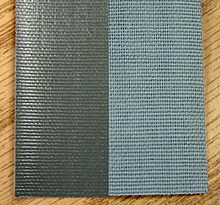
Muslin is a cotton fabric of plain weave. It is made in a wide range of weights from delicate sheers to coarse sheeting. It gets its name from the city of Mosul, Iraq, where it was first manufactured.

Hat-making or millinery is the design, manufacture and sale of hats and other headwear. A person engaged in this trade is called a milliner or hatter.
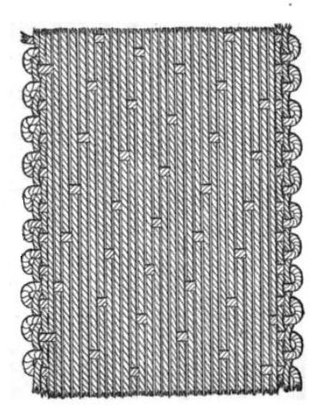
A satin weave is a type of fabric weave that produces a characteristically glossy, smooth or lustrous material, typically with a glossy top surface and a dull back; it is not durable, as it tends to snag. It is one of three fundamental types of textile weaves alongside plain weave and twill weave.

Poplin, also called tabinet, is a fine wool, cotton or silk fabric that has a vertical warp and a horizontal weft. Nowadays, the name refers to a strong material in a plain weave of any fiber or blend, with crosswise ribs that typically give a corded surface.

Library binding can be divided into the two major categories of "original" and "after market". The original category is as it says: the book was originally bound with the idea that it would be used in a library setting where the book would receive harder use than those usual trade editions sold to the public.
Lawn cloth or lawn is a fine plain weave textile, made with fine combed cotton. Terms also used include batiste and nainsook. Originally the name applied to plain weave linen, and linen lawn is also called "handkerchief linen". The term lawn is also used in the textile industry to refer to a type of starched crisp finish given to a cloth product. The finish can be applied to a variety of fine fabrics, prints or plain.

In the manufacture of cloth, warp and weft are the two basic components in weaving to transform thread and yarn into textile fabrics. The vertical warp yarns are held stationary in tension on a loom (frame) while the horizontal weft is drawn through the warp thread. In the terminology of weaving, each warp thread is called a warp end ; a pick is a single weft thread that crosses the warp thread.

Crêpe, also spelled crepe or crape, is a silk, wool, or synthetic fiber fabric with a distinctively crisp and crimped appearance. The term "crape" typically refers to a form of the fabric associated specifically with mourning. Crêpe was also historically called "crespe" or "crisp".

Khadi, derived from khaddar, is a hand-spun and woven natural fibre cloth promoted by Mahatma Gandhi as swadeshi (self-sufficiency) for the freedom struggle of the Indian subcontinent, and the term is used throughout India, Pakistan and Bangladesh. The first piece of the hand-woven cloth was manufactured in the Sabarmati Ashram during 1917–18. The coarseness of the cloth led Gandhi to call it khadi. The cloth is made from cotton, but it may also include silk or wool, which are all spun into yarn on a charkha. It is a versatile fabric that remains cool in summer and warm in winter. To improve its appearance, khadi is sometimes starched to give it a stiffer feel. It is widely accepted in various fashion circles.
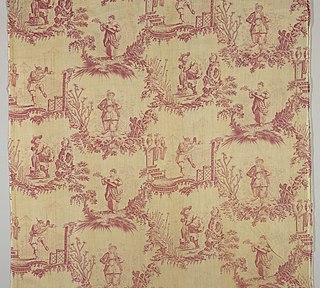
Percale is a closely woven plain-weave fabric often used for bed covers. Percale has a thread count of about 140 or higher and is noticeably tighter than twill or sateen. It has medium weight, is firm and smooth with no gloss, and washes very well. It is made from both carded and combed yarns, and may be woven of various fibers, such as cotton, polyester, or various blends.

Ticking is a type of cloth, traditionally a tightly-woven cotton or linen textile. It is traditionally used to cover tick mattresses and bed pillows. The tight weave makes it more durable and hinders the stuffing from poking through the fabric. To make it even tighter, ticking could be waxed, soaped, or starched. Tick materials designed to hold foam may be knit, or more porous. In English-speaking countries ticking commonly has a striped design, in muted colors such as brown, grey or blue, and occasionally red or yellow, against a plain, neutral background.

Gauze is a thin, translucent fabric with a loose open weave. In technical terms, "gauze" is a weave structure in which the weft yarns are arranged in pairs and are crossed before and after each warp yarn, keeping the weft firmly in place. This weave structure is used to add stability to the fabric, which is important when using fine yarns loosely spaced. However, this weave structure can be used with any weight of yarn, and can be seen in some rustic textiles made from coarse hand-spun plant fiber yarns. Gauze is widely used for medical dressings.

Bands are a form of formal neckwear, worn by some clergy and lawyers, and with some forms of academic dress. They take the form of two oblong pieces of cloth, usually though not invariably white, which are tied to the neck. When worn by clergy, they typically are attached to a clerical collar. The word bands is usually plural because they require two similar parts and did not come as one piece of cloth. Those worn by clergy are often called preaching bands or Geneva bands; those worn by lawyers are called barrister's bands or, more usually in Ireland and Canada, tabs.

Plain weave is the most basic of three fundamental types of textile weaves. It is strong and hard-wearing, and is used for fashion and furnishing fabrics. Fabrics with a plain weave are generally strong, durable, and have a smooth surface. They are often used for a variety of applications, including clothing, home textiles, and industrial fabrics.
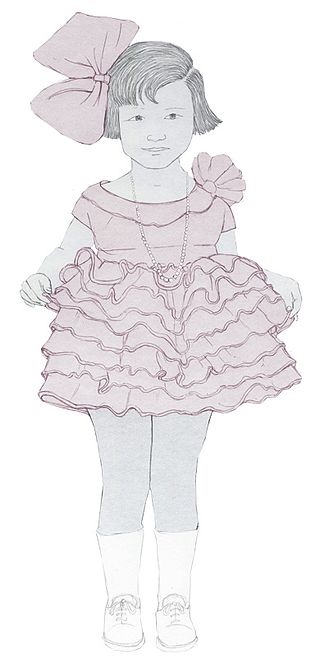
Organdy, also spelled Organdie, is a kind of fabric. It is a lightweight, balanced plain weave made of cotton with features of sheerness and crispness.
The manufacture of textiles is one of the oldest of human technologies. To make textiles, the first requirement is a source of fiber from which a yarn can be made, primarily by spinning. The yarn is processed by knitting or weaving, which turns yarn into cloth. The machine used for weaving is the loom. For decoration, the process of colouring yarn or the finished material is dyeing. For more information of the various steps, see textile manufacturing.

Grosgrain is a type of fabric or ribbon defined by the fact that its weft is heavier than its warp, creating prominent transverse ribs. Grosgrain is a plain weave corded fabric, with heavier cords than poplin but lighter than faille, and is known for being a firm, close-woven, fine-corded fabric. Grosgrain has a dull appearance, with little luster in comparison to many fabric weaves, such as satin, often used for ribbons; however, it is comparatively very strong. Grosgrain fabric is most commonly available in black, but grosgrain ribbon comes in a large variety of colors and patterns. The ribbon is very similar to Petersham ribbon in its appearance, but it does not have the ability to follow the curves of a surface or edge the way that the latter does.

Caroline Reboux was a Parisian milliner and French fashion designer. She opened her first boutique at 23 rue de la paix in Paris in 1865, which she continued to operate throughout her life. Reboux opened other shops in Paris and London starting in 1870. She trained other milliners who became famous in their own right, including American milliner Lilly Daché and French milliner Rose Valois. Reboux's most famous shop was located at 9 Avenue Matignon in Paris, which carried on operating after her death for almost three decades under the direction of Lucienne Rabaté known as "Mademoiselle Lucienne" the most famous parisian milliner at that time.
Seerhand muslin (Seerhand) was a plain weave thin cotton fabric produced in the Indian subcontinent.
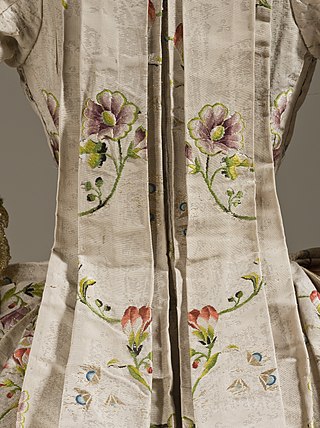
Faille is a type of cloth with flat ribs, often made in silk. It has a softer texture than grosgrain, with heavier and wider cords or ribs. Weft yarns are heavier than warp, and it is manufactured in plain weaving. It was especially popular in the 19th century.
